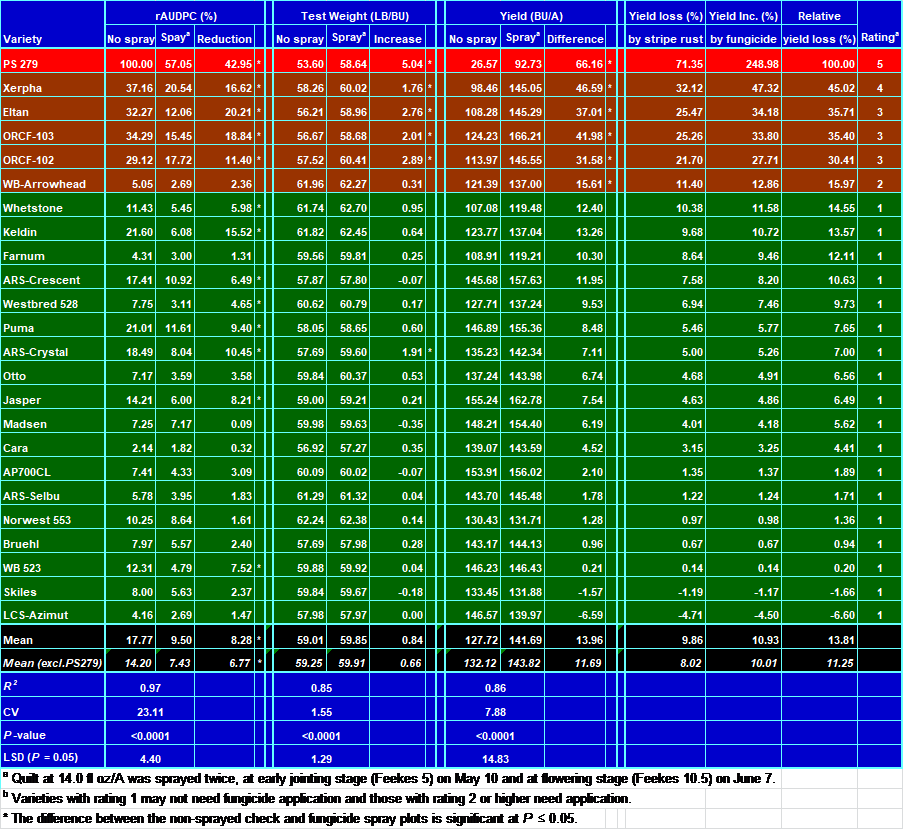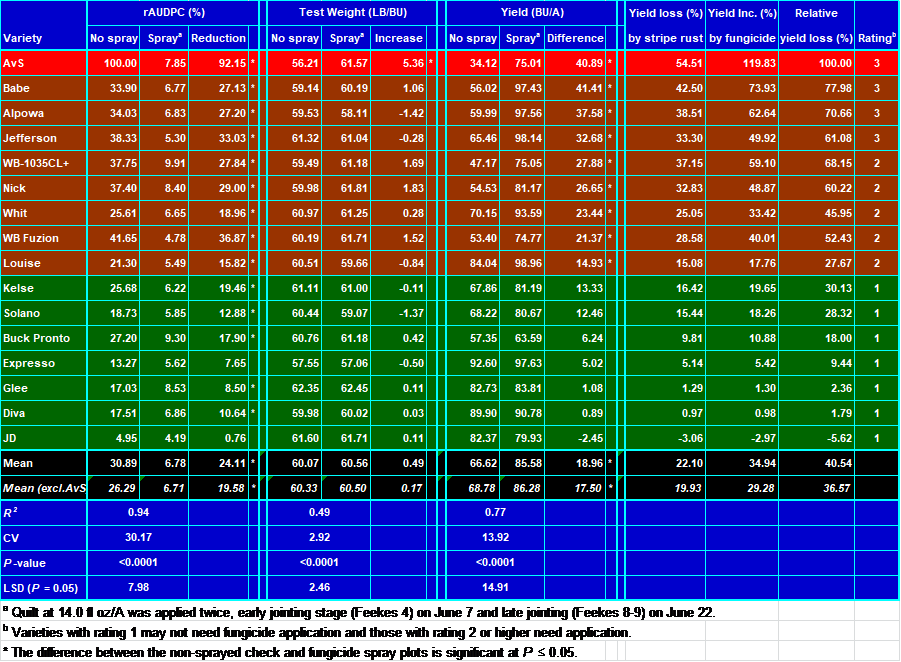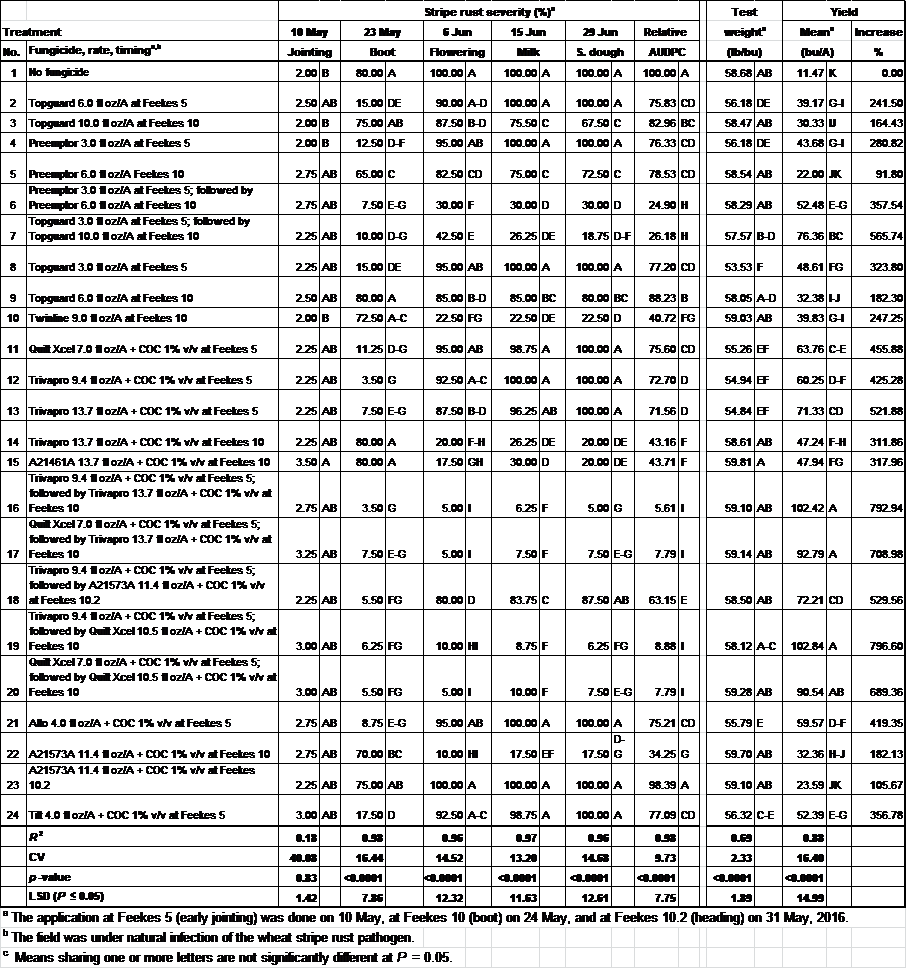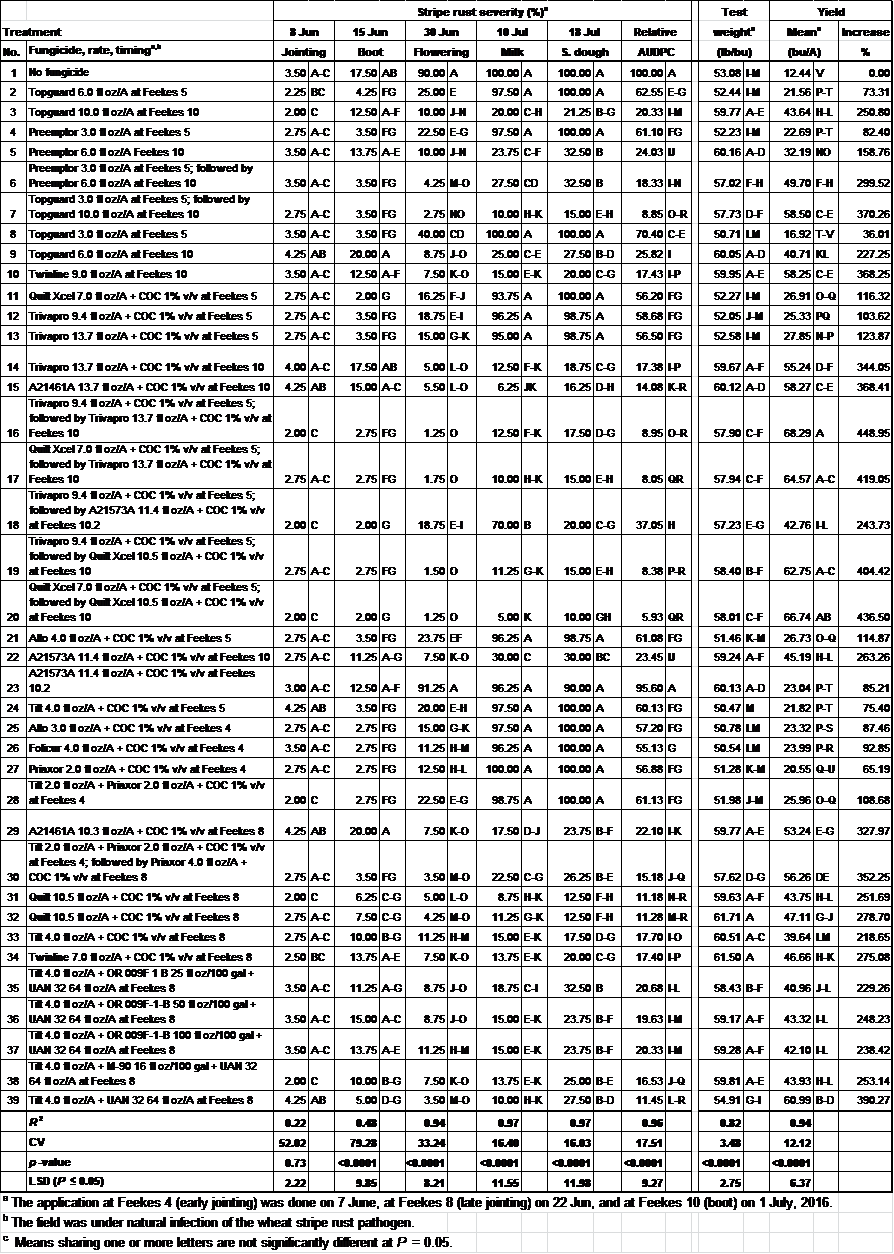First Forecast of Stripe Rust for 2017 and 2016 Fungicide and Variety Yield Loss Tests
Xianming Chen
First forecast for the eastern PNW in 2017
The current forecast is that highly susceptible winter wheat varieties would have 6% yield loss, in the low epidemic level range (0-20% yield loss). Based on this forecast, currently grown varieties would not have significant yield loss and early fungicide application at the time of herbicide application time for winter wheat would not be necessary. This forecast is based on only the temperatures of November and December, 2016 and does not include snow cover into the models. If snow cover has been and will be about 3 inches or higher during the periods of temperatures below 14oF, the stripe rust fungus in wheat leaves will likely survive the winter. If so, the stripe rust level will be higher than the forecasted value. Therefore, more accurate forecast will depend upon whether or not and to what degree the pathogen will survive throughout the winter. In early March, we will make another forecast based on the weather conditions of the entire winter season, which is generally more accurate than the early forecast. We will also check in early March if rust survives the winter.
On November 8, 2016, we were checking winter wheat fields in Whitman, Lincoln, Adams, Grant, Douglas, and Benton counties in eastern Washington. High rust incidences were found in many fields. After that, there were several reports of stripe rust in eastern Washington, northeastern Oregon, and southern Idaho. The stripe rust infection in the fall was the most severe and widespread in the eastern Pacific Northwest (PNW). The cold weather conditions (below 14oF) should have killed some rust, but snow cover could protect the rust fungus in wheat leaves.
Yield losses caused by stripe rust and increases by fungicide application on wheat varieties in 2016
Stripe rust and yield differences in non-sprayed and fungicide-sprayed plots of winter wheat varieties are shown in Table 1 and of spring wheat varieties in Table 2.
Of the 24 winter wheat varieties tested including susceptible check ‘PS 279’, 13 varieties (PS 279, Xerpha, Eltan, ORCF-103, ORCF-102, Whetstone, Keldin, ARS-Crescent, Westbred 528, Puma, ARS-Crystal, Jasper, and WB 523) had significant differences in stripe rust severity (presented as rAUDPC) between the non-sprayed and sprayed treatments; 6 varieties (PS 279, Xerpha, Eltan, ORCF-103, ORCF-102, and ARS-Crystal) had significant differences in grain test weight; and 6 varieties (PS 279, Xerpha, Eltan, ORCF-103, ORCF-102, and WB-Arrowhead) had significant differences in yield (Table 1). Stripe rust caused 71% yield loss on the susceptible check (PS 279) and from 0 to 32% yield losses at an average of 8% on commercially grown varieties. Fungicide application increased yield by 0 to 47% at an average of 10% on commercially grown varieties. Under the extreme severe level of stripe rust epidemic, five (Xerpha, Eltan, ORCF-103, ORCF-102, and WB-Arrowhead) of the tested commercially grown winter varieties needed fungicide application as they had significant yield losses and received fungicide application ratings 2 to 4. All other tested commercial varieties did not have significant yield losses and received fungicide application rating of 1 and therefore, did not need fungicide application.
Similarly, of the 16 spring wheat varieties tested including susceptible check ‘AvS’, all had significant differences in stripe rust severity (presented as rAUDPC), except Expresso and JD; only AvS had significant difference in grain test weight; and nine varieties had significant differences in grain yield (Table 2). Stripe rust caused 54% yield loss on the susceptible check and from 0 to 43% yield losses at an average of 20% on commercial varieties. Fungicide application increased grain yields by 0 to 74% on commercial varieties at an average of 29%. The nine varieties that had significantly different yield losses received fungicide application ratings 2 or 3, while the remaining seven varieties that did not have significantly different yields between sprayed and non-sprayed treatments received rating 1 and therefore, did not need fungicide application under the severe epidemic.
The data can be used to select stripe rust resistant varieties to plant and to determine if fungicide application is needed for a variety based on the relative yield loss and potential epidemic level. The current forecasted epidemic level (6% yield loss on susceptible varieties) for 2017 is similar to the stripe rust situation in 2014. Therefore, fungicide application will be generally unnecessary, unless future forecasts and situations are changed.
Fungicide tests in 2016
Various foliar fungicide treatments were tested for their effectiveness on winter wheat and spring wheat grown in fields near Pullman, Washington. Severe stripe rust epidemic occurred naturally.
In winter wheat field, stripe rust started developing in late April when plants were at the early jointing stage (Feekes 4) and reached 80% and 100% severity at the boot (Feekes 10) and flowering (Feekes 10.5) stages, respectively in the non-treated check plots (Table 3). All fungicide treatments of the first application significantly reduced rust severity compared to the non-treated check and the treatments without the first application at the boot stage. All treatments with only the first application did not significantly reduce rust severity compared to the non-treated check at the flowering stage, except one treatment. Significant differences in test weight were observed among the fungicide treatments. Treatments of only the first application had significantly low test weight compared to those with the later applications. Most treatments significantly increased gain yield compared with the non-treated check, and the significant increases ranged from 19 bushes (164%) to 91 bushes (797%).
In the spring wheat field, stripe rust started developing in late May when plants were at the tillering stage (Feekes 2-3) and reached 90% at the flowering (Feekes 10.5) and 100% severity at the milk stages in the non- fungicide check plots (Table 4). All fungicide treatments with the first application significantly reduced rust severity compared to the non-treated check and the treatments without the first application at the boot stage, and all treatments with only the first application did not significantly reduce rust severity compared to the non-treated check at the milk (data not presented) and soft dough stages. Significant differences in grain test weight were observed among the fungicide treatments. The test weights from treatments of only the first application were similar to that of non-treated check; and those of treatments with the late application were significantly higher than that of the non-treated check, except few treatments. Most fungicide treatments significantly increased yield compared with the non-treated check. The significant increases of grain yield ranged from 8 bushes (65%) to 56 bushes (449%) depending upon fungicide treatments.

Table 1. Differences in stripe rust severity (as rAUDPC), test weight, and yield in non-sprayed (check) and fungicide sprayed plots of winter wheat varieties tested under natural infection of the stripe rust pathogen near Pullman, WA in 2016

Table 2. Differences in stripe rust severity (as rAUDPC), test weight, and yield in non-sprayed (check) and fungicide sprayed plots of spring wheat varieties tested under natural infection of the stripe rust pathogen near Pullman, WA in 2016

Table 3. Stripe rust severities and relative area under the disease progress curve (AUDPC), test weight, and yield in susceptible winter wheat (‘PS 279’) field plots not sprayed (No fungicide) or sprayed with various fungicide treatments under natural infection of the stripe rust pathogen near Pullman, WA in 2016

Table 4. Stripe rust severities and relative area under the disease progress curve (AUDPC), test weight, and yield in susceptible spring wheat (‘AvS’) field plots not sprayed (No fungicide) or sprayed with various fungicide treatments under natural infection of the stripe rust pathogen near Pullman, WA in 2016